Fly Fishing Flies
Fly fishing is fun and easy to learn. You can fly fish anywhere, from the shore of a lake or from a boat on the ocean waves. To start fly fishing you need a fly rod, a line and some artificial flies. Here we have all the information you need about how to fly cast, where to fish, tips and more.
Best Fishing Flies
Flies are tied in the sizes, colors and patterns that best match local terrestrial and aquatic insects, baitfish, or other prey attractive to the type of fish you're trying to catch. In other words, you "match the hatch."
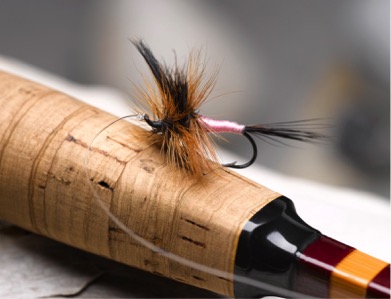
Flies used in fly fishing imitate both the immature and adult stages of insects, as well as baitfish, leeches and worms. Most flies fit into these six categories:
DRY FLIES
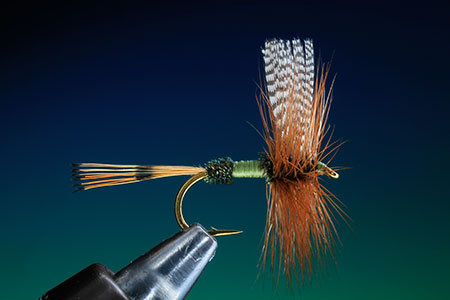
Dry flies and other surface flies represent adult aquatic insects as they emerge from the water. They also represent other food sources that have fallen into the water like grasshoppers or mice. Dry flies are good for trout, panfish and bass. And there’s nothing more exciting than watching a fish rise up and take your fly on the surface. See chart below for classic dry fly patterns.
NYMPHS
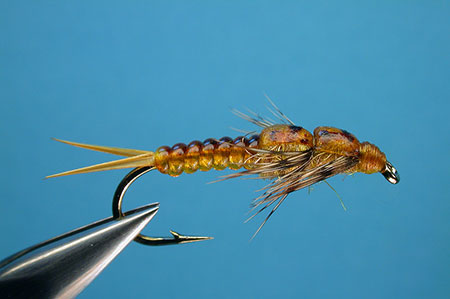
Nymphs are imitations of young insects in their larval form that live in the water. Fished on or near the bottom of lakes and rivers, nymphs are very effective for trout, panfish, salmon and steelhead. See chart below for classic nymph patterns.
STREAMERS
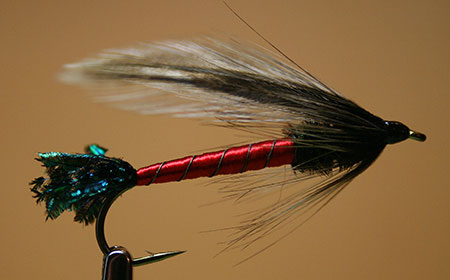
Streamers imitate baitfish, leeches and crayfish, which are all primary food sources for fish. Streamers are fished throughout the water column in both rivers and lakes. Virtually every species of fish can be caught with a streamer.
WET FLIES
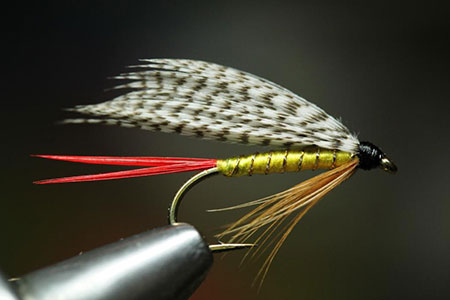
Wet flies imitate aquatic insects as they swim to the surface. They are very effective when used for trout, panfish, bass, salmon and steelhead
SALMON FLIES
Salmon flies are designed for both Pacific and Atlantic salmon as well as for steelhead. These flies often don’t imitate anything specific in nature but are meant to trigger an aggressive response.
SALTWATER FLIES

Saltwater flies represent the many food sources found in the ocean. From baitfish to crab and even shrimp, these patterns can catch everything from bonefish to tarpon.
THE BASIC BOX
This chart shows fly patterns that will serve you well for all of your freshwater fishing - from bass to trout and panfish. You may have trouble "matching the hatch" sometimes because, about 10 percent of the time, freshwater fish focus on one abundant water-born insect and become so choosy that they will take only a close imitation; but these flies can catch most fish most of the time.

Starter Fishing Flies
Many of the lures fly fishers use to catch fish on a fly are designed to duplicate the immature and adult stages of aquatic insects such as mayflies, caddisflies, stoneflies, damselflies, dragonflies, midges and others.
Many other types of fish food are also represented by flies, including baitfish, leeches, worms, crustaceans and scuds. So the term "fly" is only generic, and it does not refer specifically to flying insects.
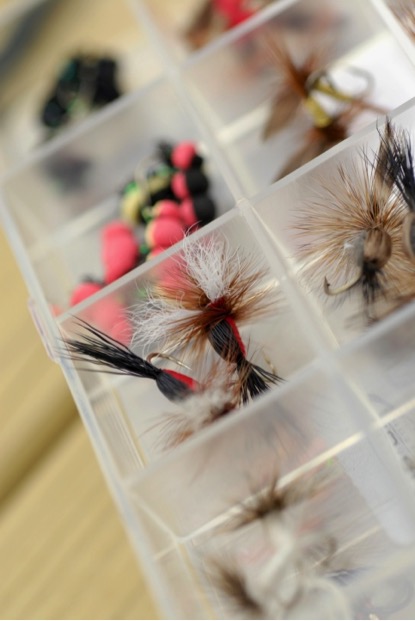
FLY GROUPS
Most flies fit into three basic categories: dry flies, nymphs (sometimes called "wet flies"), and streamers. When you visit a fly shop or browse through a mail-order catalog, you will usually find flies displayed or listed under these general groups.
DRY FLIES
Dry flies float on the water's surface, and they imitate a wide range of foods, including adult mayflies, caddisflies, midges, grasshoppers, crickets, ants and many others. The magic of seeing a trout, bass or panfish take a dry fly floating on the surface of the water is one of the greatest sights in fly fishing. Deer-hair bass bugs and poppers, used for largemouth and smallmouth bass and panfish, are also dry flies because they float on the surface.
NYMPHS/WET FLIES

Nymphs and wet flies represent the immature life stages of insects such as mayflies, caddisflies, stoneflies and others. These flies are fished below the water's surface and usually work best just prior to a hatch of water-born insects, when the nymphs and pupae that they represent become active.
Some special nymphs that imitate the emerging adult insect are fished just below or in the water's surface film. Called emergers, these flies are half wet and half dry; but because they don't float on top of the surface film, we'll include them with the nymphs and wet flies.
STREAMERS

Streamers are the flies that represent minnows, sculpins, leeches and other swimming food items that provide meals for bass, trout, panfish and saltwater fish such as tarpon, redfish, bonefish and striped bass. Although all fish, regardless of size, will strike streamers, these flies are well known for their ability to take the largest fish in streams, ponds, lakes and saltwater.
FLY SIZES

Fly sizes are referred to by a number that denotes the size of the hook on which the fly is tied. For most trout flies, the larger the number, the smaller the fly. For example, a size 18 Adams (#18 Adams) is smaller than a size 12 Adams. In sizes smaller than #2, sizes are represented by even numbers, so in our example there is a difference of four hook sizes between the #12 and #18 Adams. Extremely large hook sizes are noted with "ought" sizes, such as 1/0 (called "one-ought" or "one-oh" in fly fishing terminology).
HOOK SIZES
For any hook size, the hook-shank length can be standard, extra-long or extra-short. Extra-long (noted as XL on hook specifications) and extra-short (XS) shanks are given in multiples of standard shank length, such as lXS or 4XL. Hook wire is also available in extra-fine and extra-heavy sizes.
Here is one of the quirks of hook terminology. With regard to size versus the hook number of large hooks with a /0 size designator, the larger the number ahead of the slant bar, the larger the hook. So a size 5/0 hook is larger than a size 2/0. And, these larger hooks increase in size by one number at a time compared to the smaller hooks that are measured only with even numbers (there are hooks in sizes #2/0, #3/0, #4/0, #5/0, etc.).
These bigger hooks are usually used for bass and saltwater flies, but fishermen who stalk really large trout sometimes use these sizes, too.
Aquatic Insects
Certain aquatic insects make up the major portion of a fish diet. The four main insect orders that emerge from our streams and lakes are mayflies, caddisflies, midges, and stoneflies.
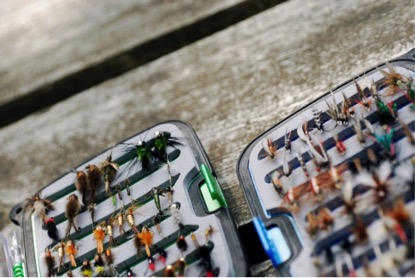
TYPES OF FLIES
To be an effective hatch-matcher you must be able to quickly differentiate between adult mayflies, caddisflies, midges, stoneflies and all the immature stages of each. Many hatches and most spinner falls do not last very long, so you don't have time to try four or five patterns. Instead, you'll need to choose the right fly at the right time; only then will you be able to hook your share of fish. It's easier than you think. Just remember to match the hatch.
MAYFLIES
The mayfly is the most important order of trout-stream insects. All mayflies have two large, upright wings; two or three tails; and most have two very small hind wings. Mayflies look like little sailboats floating in the current and are the only trout-stream insects with upright wings. The life cycle is: egg, nymph, dun, spinner.
CADDISFLIES
Caddisfiles are also very important insects, and in some locations they are even more numerous than mayflies. Caddisflies can easily be distinguished by their four wings of nearly equal length, which are covered with tiny hairs and, when at rest, are carried in an inverted V or tent over the back. Caddisflies are usually medium to small in size (#14 to #24) and have no tails. There are more than 1,000 known species on this continent.
MIDGES
Midges have only two short wings (shorter than the body), which lie flat along the top of the body, usually slightly to the side in a V, and they have no tails. Most midges are small, size 22 to 28 or smaller. The life cycle is egg, larva, pupa, adult. At hatch time the pupa ascends to the surface where it drifts for a time; the winged insect then emerges and flies away.
During the hatch, a pupa or stillborn artificial midge is usually effective; a hackled adult type can be used later during the emergence or at the egg-laying flight.
STONEFLIES
This small order of flies is of very little importance in slow waters, yet in turbulent, rocky streams, such as the Madison and the Big Hole in Montana, stoneflies provide the largest flies and the most spectacular fishing of the season. In certain Oregon streams, stoneflies are the second most important fish food. Stoneflies vary in size from very large to very small (#2 to #20). Adult stoneflies have four long wings, which are hard, shiny, heavily veined, and held flat over the back when at rest.
OTHER FOOD ITEMS
Trout and other freshwater gamefish feed on many other food items besides the four major orders. Although these other orders are normally of lesser importance, when they are numerous, fish will feed on them selectively, so a few representative imitations should be carried for the other aquatic, semi-aquatic or terrestrial forms, such as dragonflies and damselflies, grasshoppers and crickets, leafhoppers, true bugs, spongilla flies, Dobsonflies, fish flies, alderflies, aquatic moths, beetles, true flies, and aquatic wasps.
Fishing with Streamers
The easiest way to catch a big fish on a fly is on a streamer - a wet fly that imitates a small baitfish that larger fish feed on. There are many streamer baitfish imitations that will catch fish in lakes, streams, ponds and in saltwater.
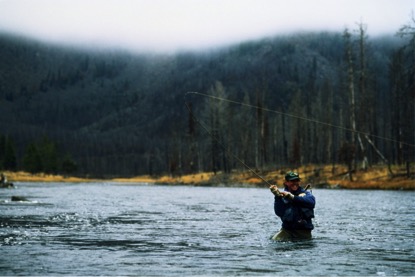
CASTING STREAMERS
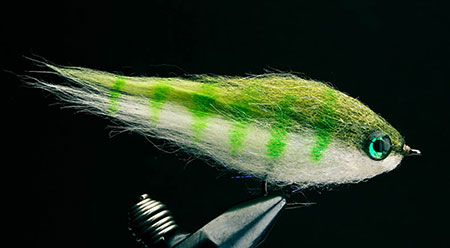
If you can cast 20 feet, you can catch fish in streams and rivers on a streamer. You can even strip line off the reel and into the water and let the fly drift in the current and catch fish. The line swims the fly, making it look like a swimming baitfish. Cast a streamer such as a Woolly Bugger into moving water, and expect a strike from a hungry fish.
To improve the action, attach a split-shot to the leader just ahead of the fly and give the fly rod tip a bounce now and then as the streamer drifts downstream. The bounce of the tip causes the fly to jig up and down like a wounded minnow, and all gamefish are hunters for wounded baitfish.
Big saltwater or freshwater streamers require bigger fly rods to cast - 7-weight, 8-weight or larger rods. The larger the fly, the larger the fish you'll catch and the larger the fly rod you'll need to cast and fight the fish (small flies can also catch large fish).
BAIT FISH STREAMERS
When fly fishing streamers, first determine which baitfish the larger fish feed on where you fish. For example, if you're fly fishing for bass in a stream and the bass there feed mostly on crayfish, you'll need a fly that looks like a crayfish. But if silver-colored minnows are their main food, then you'll want to use a silver minnow streamer.
While the fly line will swim the fly in moving water, it will not swim it in the still waters of ponds and lakes. You have to swim the fly by casting and retrieving the fly. The farther you can cast, the longer your retrieve of the fly and the more fish you'll catch.
Different lines retrieve the fly at different levels in the water. For instance a floating line will fish and retrieve the fly near the surface. But if the fish are deep, you need to get the fly deep to catch them. And you'll need a sinking line to get the fly down to the fish.
FLY LINE WEIGHT
Sinking lines are heavier than water. The heavier the line (Type 1 or I sinks slowest and Type 5 or V sinks fastest), the faster it sinks. In deep water or fast-moving water you need a Type V line to reach bottom with the streamer. In slow-moving shallow water you need a floating line or a Type I. On lakes an intermediate line or a Uniform Sinking line from Scientific Anglers are great for fly fishing streamers below the surface.
Fly fishing the streamer in ponds or lakes is simple - cast and retrieve it with a slow hand-twist retrieve or simply let it swing and follow behind the boat or float-tube as you move. The fish will do the rest.
When fly fishing the streamer in streams, simply cast the streamer across the current and let the flow take it downstream. Most of your strikes will happen at the bottom of the swing. Cast the streamer toward the bank when fishing from a boat and retrieve it fast. Bass and trout will leap on it!
OTHER FLIES
Streamers can serve you very well on the water when you’re aiming to catch larger fish. However, don’t forget about using dry flies and nymphs to catch a variety of great fish, as well. See a chart that lists the classic patterns for dry flies and nymphs.
